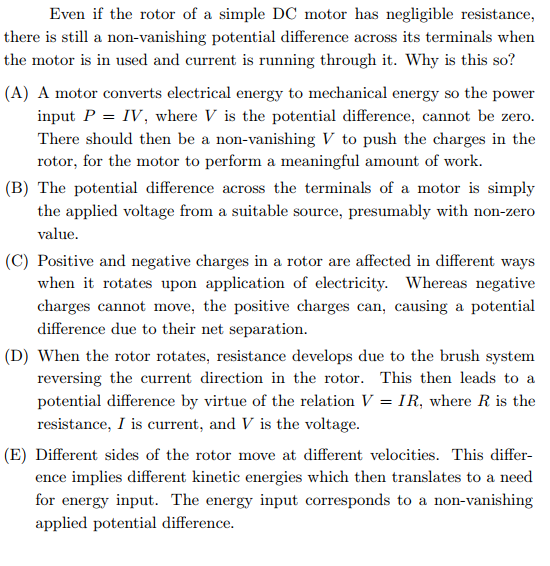Even if the rotor of a simple DC motor has negligible resistance, there is still a non-vanishing potential difference across its terminals when the motor is in used and current is running through it. Why is this so? (A) A motor converts electrical energy to mechanical energy so the power input P = IV, where V is the potential difference, cannot be zero. There should then be a non-vanishing V to push the charges in the rotor, for the motor to perform a meaningful amount of work. (B) The potential difference across the terminals of a motor is simply the applied voltage from a suitable source, presumably with non-zero value. (C) Positive and negative charges in a rotor are affected in different ways when it rotates upon application of electricity. Whereas negative charges cannot move, the positive charges can, causing a potential difference due to their net separation. (D) When the rotor rotates, resistance develops due to the brush system reversing the current direction in the rotor. This then leads to a potential difference by virtue of the relation V = IR, where R is the resistance, I is current, and V is the voltage. (E) Different sides of the rotor move at different velocities. This differ- ence implies different kinetic energies which then translates to a need for energy input. The energy input corresponds to a non-vanishing applied potential difference.
Even if the rotor of a simple DC motor has negligible resistance, there is still a non-vanishing potential difference across its terminals when the motor is in used and current is running through it. Why is this so? (A) A motor converts electrical energy to mechanical energy so the power input P = IV, where V is the potential difference, cannot be zero. There should then be a non-vanishing V to push the charges in the rotor, for the motor to perform a meaningful amount of work. (B) The potential difference across the terminals of a motor is simply the applied voltage from a suitable source, presumably with non-zero value. (C) Positive and negative charges in a rotor are affected in different ways when it rotates upon application of electricity. Whereas negative charges cannot move, the positive charges can, causing a potential difference due to their net separation. (D) When the rotor rotates, resistance develops due to the brush system reversing the current direction in the rotor. This then leads to a potential difference by virtue of the relation V = IR, where R is the resistance, I is current, and V is the voltage. (E) Different sides of the rotor move at different velocities. This differ- ence implies different kinetic energies which then translates to a need for energy input. The energy input corresponds to a non-vanishing applied potential difference.
Glencoe Physics: Principles and Problems, Student Edition
1st Edition
ISBN:9780078807213
Author:Paul W. Zitzewitz
Publisher:Paul W. Zitzewitz
Chapter25: Electromagnetic Induction
Section: Chapter Questions
Problem 69A
Related questions
Question

Transcribed Image Text:Even if the rotor of a simple DC motor has negligible resistance,
there is still a non-vanishing potential difference across its terminals when
the motor is in used and current is running through it. Why is this so?
(A) A motor converts electrical energy to mechanical energy so the power
input P = IV, where V is the potential difference, cannot be zero.
There should then be a non-vanishing V to push the charges in the
rotor, for the motor to perform a meaningful amount of work.
(B) The potential difference across the terminals of a motor is simply
SS
the applied voltage from a suitable source, presumably with non-zer
value.
(C) Positive and negative charges in a rotor are affected in different ways
when it rotates upon application of electricity. Whereas negative
charges cannot move, the positive charges can, causing a potential
difference due to their net separation.
(D) When the rotor rotates, resistance develops due to the brush system
reversing the current direction in the rotor. This then leads to a
potential difference by virtue of the relation V = IR, where R is the
resistance, I is current, and V is the voltage.
(E) Different sides of the rotor move at different velocities. This differ-
ence implies different kinetic energies which then translates to a need
for energy input. The energy input corresponds to a non-vanishing
applied potential difference.
Expert Solution
This question has been solved!
Explore an expertly crafted, step-by-step solution for a thorough understanding of key concepts.
Step by step
Solved in 2 steps

Knowledge Booster
Learn more about
Need a deep-dive on the concept behind this application? Look no further. Learn more about this topic, physics and related others by exploring similar questions and additional content below.Recommended textbooks for you

Glencoe Physics: Principles and Problems, Student…
Physics
ISBN:
9780078807213
Author:
Paul W. Zitzewitz
Publisher:
Glencoe/McGraw-Hill


Glencoe Physics: Principles and Problems, Student…
Physics
ISBN:
9780078807213
Author:
Paul W. Zitzewitz
Publisher:
Glencoe/McGraw-Hill
